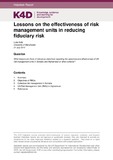| dc.contributor.author | Kelly, Luke | |
| dc.coverage.spatial | Somalia | en |
| dc.coverage.spatial | Afghanistan | en |
| dc.date.accessioned | 2019-09-02T13:57:56Z | |
| dc.date.available | 2019-09-02T13:57:56Z | |
| dc.date.issued | 2019-07-31 | |
| dc.identifier.citation | Kelly, L. (2019). Lessons on the effectiveness of risk management units in reducing fiduciary risk. K4D Helpdesk Report. Brighton, UK: Institute of Development Studies. | en |
| dc.identifier.uri | https://opendocs.ids.ac.uk/opendocs/handle/20.500.12413/14672 | |
| dc.description.abstract | There is a limited amount of literature on the lessons regarding the effectiveness of UN risk management units (RMUs) in Somalia and Afghanistan. Responses from stakeholders interviewed is broadly positive. Discussion on risk management includes a range of methods used by non-governmental organisations (NGOs). This also includes a common recommendation for more co-ordination and harmonisation among donors. The risk of fraud, diversion and misappropriation of funds has led NGOs and UN agencies to focus on risk management practices, including remote programming, withdrawal, third party monitoring (TPM) and a broad range of enterprise risk management (ERM) processes. This in turn has led to calls for mechanisms to collectively manage risk in certain contexts. The UN risk management unit in Somalia (2011) has been replicated in Afghanistan (2014) and cited as a potentially useful example. The literature review is largely focused on grey literature and policy papers. While there is some documentation on the aims and functions of Risk Management Units, there are only partial evaluations of their effectiveness based on interviews. The literature on risk management provides examples from a variety of contexts from which indirect lessons can be drawn. A number of papers cite interviews pointing to the value of RMUs or similar mechanisms, or reflect on the problems brought by the absence of any collective mechanism. This review has therefore only been able to make partial conclusions as to the effectiveness of RMUs in fragile settings. The literature review is gender-blind and disability-blind. | en |
| dc.language.iso | en | en |
| dc.publisher | IDS | en |
| dc.relation.ispartofseries | K4D Helpdesk Report;643 | |
| dc.rights.uri | https://www.nationalarchives.gov.uk/doc/open-government-licence/version/3/ | en |
| dc.subject | Aid | en |
| dc.subject | Finance | en |
| dc.subject | Governance | en |
| dc.title | Lessons on the Effectiveness of Risk Management Units in Reducing Fiduciary Risk | en |
| dc.type | Helpdesk | en |
| dc.rights.holder | © DFID - Crown copyright 2019 | en |
| dcterms.dateAccepted | 2019-07-31 | |
| rioxxterms.funder | Department for International Development, UK Government | en |
| rioxxterms.identifier.project | K4D | en |
| rioxxterms.version | VoR | en |
| rioxxterms.funder.project | 238a9fa4-fe4a-4380-996b-995f33607ba0 | en |

